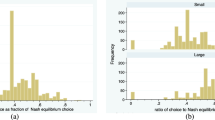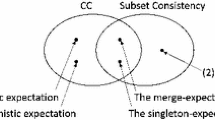Abstract
Two institutions that are often implicit or overlooked in noncooperative games are the assumption of Nash behavior to solve a game, and the ability to correlate strategies. We consider two behavioral paradoxes; one in which maximin behavior rules out all Nash equilibria (‘Chicken’), and another in which minimax supergame behavior leads to an ‘inefficient’ outcome in comparison to the unique stage game equilibrium (asymmetric ‘Deadlock’). Nash outcomes are achieved in both paradoxes by allowing for correlated strategies, even when individual behavior remains minimax or maximin. However, the interpretation of correlation as a public institution differs for each case.
Similar content being viewed by others
REFERENCES
Arce M., D.G.: 1994, ‘Alternative Stability Criteria for Social Norms. With Applications to the Prisoner’s Dilemma’, Journal of Conflict Resolution, 38, 749-765.
Arce M., D.G.: 1995, ‘The Economic Consequences of the Peace: Keynes and Correlation’, Mathematical Social Sciences, 29, 263-276.
Armijo, L.E.: 1996, ‘Inflation and Insouciance: The Peculiar Brazilian Game’, Latin American Research Review, 31, 7-46.
Aumann, R.J.: 1974, ‘Subjectivity and Correlation in Randomized Strategies’</del>, Journal of Mathematical Economics, 1, 67-96.
Aumann, R.J.: 1981, ‘Survey of Repeated Games’, in Essays in Game Theory and Economics in Honor of Oskar Morgenstern, Mannheim: Bibliographisches Institut, pp. 11-42.
Aumann, R.J.: 1987, ‘Correlated Equilibrium as an Expression of Bayesian Rationality’, Econometrica, 55, 1-18.
Barany, I.: 1992, ‘Fair Distributions Protocols or How the Players Replace Fortune’, Mathematics of Operations Research, 17, 327-340.
Basu, K.: 1995, ‘Civil Institutions and Evolution: Concepts, Critiqueand Models’, Journal of Development Economics, 46, 19-33.
Becker, G.S.: 1983, ‘A Theory of Competition Among Pressure Groups for Political Influence’, Quarterly Journal of Economics, 98, 371-400.
Bernheim, B.D.: 1984, ‘Rationalizable Strategic Behavior’, Econometrica, 52, 1007-1028.
Binmore, K. and Samuelson, L.: 1994, ‘An Economist’s Perspective on Social Norms’, Journal of Institutional and Theoretical Economics, 150, 45-63.
Brams, S.J.: 1992, ‘A Generic Negotiation Game’, Journal of Theoretical Politics, 4, 53-66.
Brams, S.J.: 1994, Theory of Moves, Cambridge: Cambridge University Press.
Cardoso, E.: 1992, ‘Debt Finance and Monetary Dynamics in Brazil and Mexico’, Journal of Development Economics, 37, 173-197.
Carter, M. and Maddock, R.: 1987, ‘Inflation: The Invisible Foot of Macroeconomics’, Economic Record, 63, 120-128.
De Finetti, B.: 1990, Theory of Probability (Translation of the 1970 text), N.Y.: Wiley Classics.
DeMarzo, Peter M.: 1992, ‘Coalitions, Leadership, and Social Norms: The Power of Suggestion in Games’, Games and Economic Behavior, 47, 72100.
Dornbusch, R. and Simonsen, M.H.: 1987, ‘Estabilización de la Inflación con el Apoyo de una Política de Ingresos’, El Trimestre Económico, 54, 225-281.
Forges, F.: 1986, ‘An Approach to Communication Equilibrium’, Econometrica, 54, 1375-1385.
Forges, F.: 1990, ‘Equilibria with Communication in a Job Market Example’, Quarterly Journal of Economics, 60, 375-398.
Goodfriend, Marvin: 1986, ‘Monetary Mystique: Secrecy and Central Banking’, Journal of Monetary Economics, 17, 63-92.
Greenberg, J.: 1990, The Theory of Social Situations, Cambridge: Cambridge University Press.
Haneke, Uwe: 1995, ‘Inflação Brasileira e Teoria de Jogos’, Revista de Economia Politica, 15, 84-98.
Hargreaves-Heap, S.P.: 1989, Rationality in Economics, N.Y.: Basil-Blackwell.
Hargreaves-Heap, S.P.: 1994, ‘Institutions and (Short-Run) Macroeconomic Performance’, Journal of Economic Surveys, 8, 35-56.
Hart, S. and Schmeidler, D.: 1989, ‘Existence of Correlated Equilibria’, Mathematics of Operations Research, 14, 18-25.
Heymann, D., Navajas F. and Warnes, I.: 1991, ‘Conflicto Distributivo y D´eficit Fiscal. Algunos Juegos Ińflacionarios’, El Trimestre Económico, 58 101-137.
Holler, M.: 1990, ‘The Unprofitability of Mixed Strategy Equilibria in Two-Person Games’, Economics Letters, 32, 319-323.
Kandori, M.: 1992, ‘Social Norms and Community Enforcement’, Review of Economic Studies, 59, 63-80.
Lipnowski, I. and Maital, S.: 1983, ‘Voluntary Provision of a Pure Public Good and the Game of “Chicken”’, Journal of Public Economics, 20, 381-386.
Miller, G. and Hammond, T.: 1994, ‘Why Politics is More Fundamental than Economics’, Journal of Theoretical Politics, 6, 5-26.
Myerson, R.B.: 1979, ‘Incentive Compatibility and the Bargaining Problem’, Econometrica, 47, 61-73.
Myerson, R.B.: 1983, ‘Mechanism Design by an Informed Principal’, Econometrica, 51, 1767-1797.
Nau, R.F. and McCardle K.F.: 1990, ‘Coherent Behavior in Noncooperative Games’, Journal of Economic Theory, 50, 424-444.
Nau, R.F. and McCardle K.F.: 1991, ‘Arbitrage, Rationality, and Equilibrium’, Theory and Decision, 32, 147-164.
Rasmusen, E.: 1992, ‘Folk Theorems for the Observable Implications of Repeated Games’, Theory and Decision, 32, 147-164.
Schotter, A.: 1981, The Economic Theory of Social Institutions, Cambridge: Cambridge University Press.
Simon, J.: 1995, ‘Reply to Comment’, Rationality and Society, 7, 421-430.
Simonsen, M.H.: 1988a, ‘Rational Expectations, Game Theory and Inflationary Inertia’, in P.W. Anderson et al. (Eds.), The Economy as an Evolving Complex System, N.Y.: Addison-Wesley, pp. 205-241.
Simonsen, M.H.: 1988b, ‘Price Stabilization and Incomes Policies: Theory and the Brazilian Case Study’, in M. Bruno et al. (Eds.), Inflation Stabilization, Cambridge: MIT Press, pp. 259-286.
Smith, J.M.: 1982, Evolution and the Theory of Games, Cambridge: Cambridge University Press.
Tullock, G.: 1992, ‘Hawks, Doves, and Free Riders’, Kyklos 45, 25-36.
Vanderschraaf, Peter: 1995, ‘Endogenous Correlated Equilibria in Noncooperative Games’, Theory and Decision, 38, 61-84.
Velasco, A.: 1987, ‘Políticas de Estabilizacióny Teoría de Juegos’, Colección de Estudios CIEPLAN, 21, 49-75.
Velasco, A.: 1991, ‘Monetarism and Structuralism: Some Macroeconomic Lessons’, in Patricio Meller (Ed.), The Latin American Development Debate, Boulder: Westview Press, pp. 43-58.
Wittman, D.: 1993, ‘Nash Equilibrium versus Maximin. A Comparative Static Analysis’, European Journal of Political Economy, 9, 559-565.
Author information
Authors and Affiliations
Rights and permissions
About this article
Cite this article
Arce, D.G. Correlated strategies as Institutions. Theory and Decision 42, 271–285 (1997). https://doi.org/10.1023/A:1004906403823
Issue Date:
DOI: https://doi.org/10.1023/A:1004906403823




